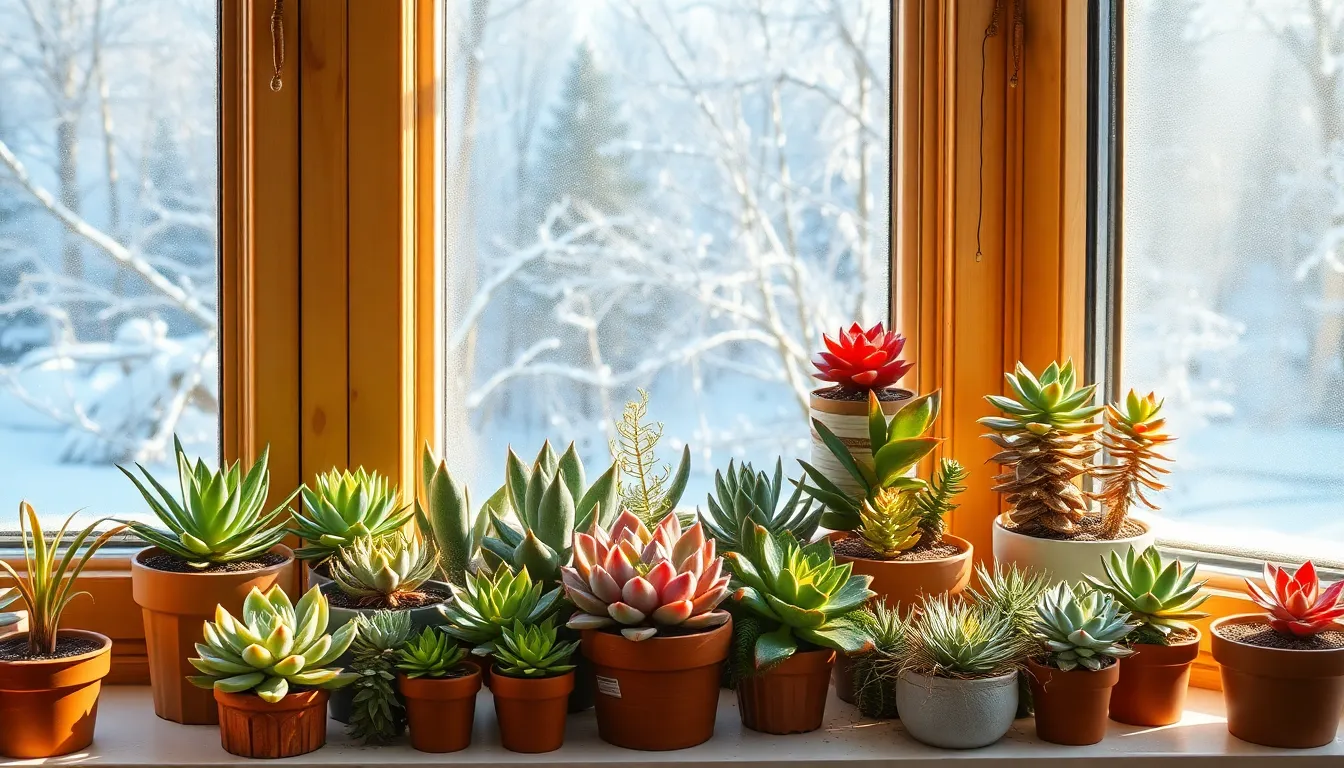
Can Succulents Survive Winter? Essential Tips to Keep Your Plants Thriving
As winter rolls in and temperatures drop, many plant lovers start to panic. Will their beloved succulents survive the chill? These resilient little plants often seem like the superheroes of the plant world, but even they have their limits. While they thrive in warm, sunny conditions, winter can throw a curveball that leaves them shivering in their pots.
Can Succulents Survive Winter
Succulents are unique plants that store water in their leaves, stems, or roots. These adaptations help them endure dry conditions, making them popular among gardeners.
What Are Succulents?
Succulents encompass a wide variety of plants known for their thick, fleshy tissues. They thrive in arid environments, gaining the ability to retain water effectively. Various species display a range of shapes, colors, and sizes, enhancing their appeal in home decor. Their resilience comes from specialized tissues that store moisture, enabling them to survive prolonged drought periods. Despite their hardiness, growing conditions significantly influence their vitality.
Common Types of Succulents
Numerous succulents are popular choices for indoor and outdoor gardening. Aloe vera, recognized for its medicinal properties, serves both functional and aesthetic purposes. Echeveria features a rosette shape, adding visual interest to arrangements. Sedum, known for its low maintenance, often creates ground covers in gardens. Agave plants stand out with their architectural forms, offering dramatic flair. Lastly, jade plants, or Crassula ovata, symbolize good luck and prosperity, making them treasured houseplants. Each type varies in care requirements, showcasing distinct characteristics.
The Winter Challenge

Winter poses significant challenges for succulents, despite their hardiness. The drop in temperatures impacts their ability to thrive.
Temperature Concerns
Temperatures below 40°F (4°C) can be harmful to many succulents, leading to potential damage. Frost can damage leaves and stems, causing them to wilt. Some varieties, like hardy Sedum, tolerate colder conditions better than others. Gardeners should monitor nighttime temperatures closely to protect sensitive species. Moving pots indoors or using frost cloths can help maintain a suitable environment. Variation in temperature greatly influences how well succulents endure winter.
Humidity and Light Levels
Winter often brings lower humidity, which can stress succulents. While they’re accustomed to dry conditions, extreme dryness can sap their moisture reserves. Providing adequate light remains crucial during these months, as shorter days limit exposure. Placing succulents near south-facing windows allows for maximum sunlight. Artificial grow lights can supplement natural light when necessary. Ensuring the right balance of humidity and light supports healthy growth during winter.
Preparing Succulents for Winter
Preparing succulents for winter involves specific care to ensure their survival. Understanding indoor and outdoor care tips is essential for maintaining their health during colder months.
Indoor Care Tips
Indoor environments require attention to light and humidity. Placing succulents near south-facing windows maximizes their exposure to natural light. Artificial grow lights can supplement when daylight is limited. Ensure indoor temperatures stay above 40°F (4°C) to prevent frost damage. Watering should be minimal during winter, as succulents enter a dormant phase. Checking soil moisture before watering is crucial; letting it dry out prevents root rot. During this period, humidity levels should remain low to avoid mold. Regularly inspect for pests, as indoor temperatures can sometimes attract them.
Outdoor Care Tips
Outdoor succulents require different preparations for winter. Covering plants with frost cloth protects them from harsh cold snaps. Grouping potted succulents together can create a microclimate, helping to retain heat. Placing pots near sheltering structures, like walls or fences, can provide additional insulation. Watering before the first frost ensures the plants start winter hydration strong. Avoid late-season watering, which can lead to root rot in cold soil. Monitor temperatures at night, as dips below 40°F (4°C) can be harmful. If possible, consider moving outdoor containers indoors when extreme weather is expected.
Signs of Stress in Winter
Winter can induce various stress symptoms in succulents. Identifying these signs early helps gardeners take action to preserve their plants.
Common Symptoms
Leaves may become shriveled or wrinkled, signaling insufficient moisture. Another symptom includes discoloration, often manifesting as a yellowing or browning of the leaves. Additionally, plants may show stunted growth due to reduced light exposure. In more severe cases, leaf drop can occur. Gardeners often notice these issues most frequently during extreme cold spells, highlighting the delicate balance succulents require in winter conditions.
How to Address Issues
Address dehydration by adjusting watering practices, ensuring the soil remains lightly moist without becoming soggy. Provide extra light by placing succulents near bright windows or using grow lights as needed. To combat discoloration, gardeners can inspect for pests, addressing any infestations promptly. Protect against cold by bringing sensitive succulents indoors or using protective coverings for outdoor plants. Observing these strategies greatly increases the likelihood of maintaining healthy plants during the winter months.
Conclusion
Winter can be a challenging time for succulents but with the right care they can survive and thrive. By understanding their specific needs and making necessary adjustments gardeners can ensure their plants remain healthy. Monitoring temperatures and providing adequate light and moisture are essential steps in winter care.
With proper attention succulents can continue to bring beauty and joy throughout the colder months. Embracing these strategies not only protects the plants but also enhances the gardening experience. As winter approaches it’s important to be proactive and attentive to the needs of these resilient yet sensitive plants.
